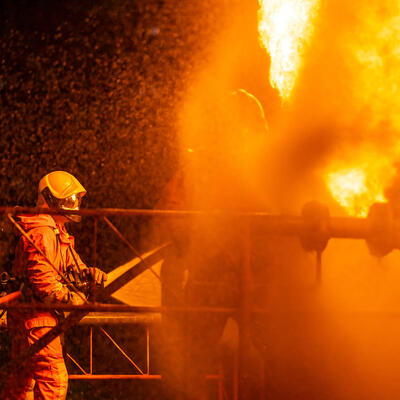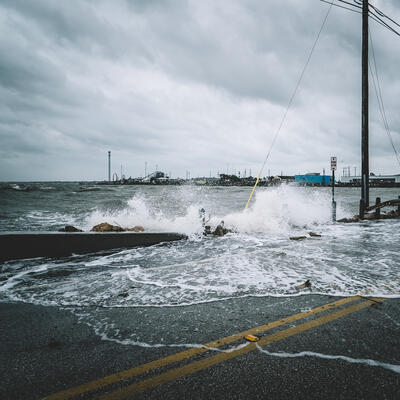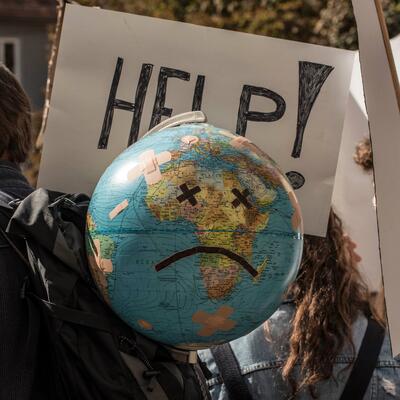
Military Power: Balancing Security and Climate Threats
Guests

Sherri Goodman

Neta C. Crawford
Summary
The U.S. military is one of the largest armed forces in the world. Its physical footprint is huge — about 750 bases across 80 countries, plus several hundred more within our borders. To give a sense of scale, Russia has around 20 foreign bases, China only has a handful.
Each of those bases needs energy — and the vast majority comes from oil or gas, which results in a massive energy footprint. And military operations – conducting exercises and engaging in warfare — uses even more energy and creates even more climate-changing pollution.
The Department of Defense has been making moves to reduce its dependence on fossil fuels. The Air Force has recently invested in electric aircraft, and several bases are tapping into geothermal energy — capturing heat from deep underground. But even with those efforts, the military’s role in fighting climate change is complicated.
Neta Crawford is a professor of International Relations at the University of Oxford. She's also co-founder and co-director of the Costs of War Project at Brown University, which builds on the work of dozens of international scholars to provide an accurate accounting of the military’s human, economic and environmental impacts.
She argues that while the Department of Defense is trying to be proactive in its response to climate threats, it’s still not doing all it can to reduce its own contributions to the cause.
“They're very innovative on bases and have done a remarkable job at increasing solar power and adopting microgrids and wind power and hydropower and geothermal. They're doing a lot. They could do more,” she says. “The DOD itself says that it has 20 percent excess capacity at bases. So they could also reduce their size. And…rethink some of the missions” – like the large presence in the Persian Gulf, for instance.
“We know that the planet is on fire,” Crawford says. “Most of human history is rooted in trade, not war. What we have now is an emergent crisis that needs to be dealt with much more creatively.”
Back in the 1990s, Sherri Goodman became the first Deputy Undersecretary of Defense for Environmental Security. She went on to work with the first group of generals and admirals to examine the national security implications of climate change. It was there, in 2007, that she first described climate change as a “threat multiplier” to convey how the destabilizing impacts of climate change – like extreme heat, fire, and violent storms – amplify and accelerate other security risks, like food and water shortages which lead to more instability and conflicts.
Goodman says that after learning the hard way in Iraq and Afghanistan that trucking fuel to the front was putting soldiers' lives at risk, the military has been working hard to “unleash from the tether of fuel.”
The challenge is to balance global security with climate threats.
“It's not just about emissions. It's about the mission that the military is tasked to perform to protect Americans,” Goodman says. “We have to be able to do both and. We have to protect our way of life and the things we value about it. And at the same time, we have to accelerate into the energy transition.”
This episode also features a reported story by NPR’s Quil Lawrence, originally broadcast on NPR’s All Things Considered on October 2, 2023.
Episode Highlights
02:00 – Neta Crawford on U.S. military emissions and energy use
05:20 – Origin of U.S. military expansion abroad for refueling
08:30 – Early military research into impacts of climate change risks
13:00 – Sherri Goodman explains how climate change is a threat multiplier
15:00 – How relying on fossil fuels makes armed forces less safe
21:15 – Why U.S. military asked for exemption from emissions reporting
27:30 – NPR’s Quil Lawrence reports on military bases using microgrids
40:00 – How U.S. military could reduce emissions without jeopardizing readiness
44:00 – Human history relies more on trade than war
Resources From This Episode (4)
Full Transcript
Note: Transcripts are generated using a combination of automated software and human transcribers and may contain errors. Please check the actual audio before quoting it.
Greg Dalton: I’m Greg Dalton.
Ariana Brocious: And I’m Ariana Brocious.
Greg Dalton: And this is Climate One. On today’s show: How the US armed forces are trying to balance global security and climate threats.
[music change]
Greg Dalton: The U.S. military is one of the largest in the world.
Ariana Brocious: Its physical footprint is huge — about 750 bases across 80 countries. To give a sense of scale, Russia has around 20 foreign bases, China only has a handful.
Greg Dalton: So we have 750 bases abroad – plus several hundred more within our borders.
Ariana Brocious: And each of those bases needs energy – and the vast majority comes in the form of oil or gas. And that results in a massive energy footprint.
Greg Dalton: The Department of Defense has been making moves to reduce its dependence on fossil fuels. The Air Force has recently invested in electric aircraft, and several bases are tapping into geothermal energy – capturing heat from deep underground. And later in the show we’ll hear about a base with its own microgrid, powered by methane captured from a landfill.
Ariana Brocious: But even with those efforts, the military’s role in fighting climate change is complicated. As our first guest today argues, although the Department of Defense is trying to be proactive in its response to climate threats, it’s still not doing all it can to reduce its own contributions to the cause. In other words: its massive use of fossil energy. Which is heating and destabilizing the planet and leading to even more climate threats.
Greg Dalton: There’s a lot to unpack in there. So let’s get into it. Neta Crawford is a Professor of International Relations at the University of Oxford. She's also co-founder and co-director of the Costs of War Project at Brown University, which builds on the work of dozens of international scholars to provide an accurate accounting of the military’s human, economic and environmental impacts. I asked her to help paint a picture of the U.S. military’s energy use today.
Neta Crawford: United States military is one of the largest emitters in the world. If it were a country, its greenhouse gas emissions would be comparable to Portugal or Switzerland in any one year. The military is the United States single largest energy user and that's been the case for many years.
Greg Dalton: Right, and most governments don't report their military emissions, and later we'll get into why that is, but how do you compare the environmental impact of day to day operations, training, etc. with actual war?
Neta Crawford: Well, we don't know the number for actual war. There are estimates. There's new methodologies that people are trying to develop to understand the impact of war on emissions. We do know that in any military like the United States, most of its emissions are from operations and when it goes to war. Its operational energy use increases and therefore its emissions increase, but many of the emissions from the war will be associated with the destruction. And then after that reconstruction.
Greg Dalton: Yeah, that was one of the things really interesting to me. I hadn't quite thought about, of course, you know, sending carriers to the Taiwan Strait or the Persian Gulf, takes a lot of fuel, to project that power across the globe. And I hadn't thought about rebuilding Gaza, rebuilding Ukraine, that's such a big part of the impact. Do you also factor ecocide in the destruction of carbon absorbing plants, et cetera?
Neta Crawford: Well, in understanding the impact of war and military mobilization, I think you have to think about three things. First, there's the military's operations in peacetime. And then the increased tempo in wartime. There's also military industrial activity. Which goes up in wartime–
Greg Dalton: All the building planes and bombers and manufacturing emissions.
Neta Crawford: That's right. So let's say Lockheed Martin or General Dynamics, which make the equipment that goes to war, have their own military industrial emissions. And it turns out that military industrial emissions happen to be more greenhouse gas intensive than civilian emissions. Then you also have to figure in the destruction of environments. And that includes deforestation or the destruction of, let's say farmland, which also holds carbon. Or, you know, contamination in the oceans. Now, if you kill, you know, large marine mammals, which have a very important role in carbon sequestration, then you're also dealing a blow in terms of holding onto carbon or sequestering carbon.
Greg Dalton: Right. And I think that even the term, ecocide, goes to the U.S. use of Agent Orange in Vietnam, sort of just destroying whole forests in Southeast Asia. So how do we get to this point? Take us back to the 1800s with the military. The military is often at the forefront of fuel shifts from burning wood to burning coal, to burning oil, to nuclear, to et cetera. So when the military shifted from sailing ships to steam engines powered by coal, take us back to that point.
Neta Crawford: The big transition here is the invention of the steam engine and immediately people realized that you could move equipment and people much more quickly and reliably with those steam engines. And the United States built a fleet of steamships. Which it then was able to power with first wood and then coal and railways, and the railway expansion is part of the story here. And it used the railways to take over the far west and, and it was a rationale for taking some of the land from Native Americans. And they also used the steamships to expand during the 1840s into Asia. But they didn't have bases there to refuel the steamships, so they had to either rent colliers from Great Britain or use existing British coaling stations. And then eventually, the United States had to get its own. because if it wanted to maintain a presence in Asia, they believed that they needed to have bases in, for instance, Pearl Harbor. And the first base in Pearl Harbor happens in the 1840s.
Greg Dalton: Right. So this is what you talk about in your book, the Pentagon, Climate Change and War, sort of the historical feedback loop, which you refer to as the deep cycle. That was we, we need fuel to go to these places. And then we have to start going after supply of these places and how this kind of goes. Our projection deepens and reinforces the need and connection to fossil fuels.
Neta Crawford: Right, so when the United States in 1852 went to China and Japan with Commodore Perry's expedition, part of the reason was, of course, to open commercial ties, but another important thing was to get access to coal, local coal, at a cheaper price than they would be able to get it from Britain. And then that interest in Asia continues, and we want more coaling stations and, and more commercial arrangements, and then we stay.
Greg Dalton: Right. And we see that happening today with oil. And that's why the U. S. is projecting the Navy into the Persian Gulf for those oil supply lines not only for the U.S., but for Europe and our other allies. So how much of the military fuel use, therefore carbon impact, is aimed at protecting oil, fossil fuel supply lines?
Neta Crawford: Well, if you look at the military budget, and the operations, it looks like about 25 percent of the effort in central command, I think you could attribute to trying to maintain access either to the fuel itself or protect its transit, or to maintain relationships with the allies who are then going to protect that fuel.
Greg Dalton: Right. And of course that's connected to climate change. In the 1950s, Professor Roger Revelle, who's in San Diego, testified about the military implications of the heating caused by burning fossil fuels. What were his predictions and how accurate was he?
Neta Crawford: Well, Revelle was trying to get the United States Congress to fund the International Geophysical Year. And in his testimony to appropriations, he said, look, as the climate warms, the Arctic will become more open, and it may become open year round, and then therefore Russia will become more open. Not just a land power, but a great naval power. Now, of course, the United States was a great naval power. And if the Soviet Union became a rival in this way, he felt that the United States' position in the world would be jeopardized. So he's arguing to Congress, look, you need to fund this basic scientific research so that we can anticipate what to do if global warming continues. So Revelle argues, in later scientific papers that the United States is engaged in, in fact, the world is engaged in, a vast experiment burning in just a few years, the coal and oil deposits, It's took millennia to make.
Greg Dalton: Right. And we're burning this stuff in a, you know, sort of fraction of time. So here's a person pointing out the geopolitical implications of climate change before most people have even heard of it. Does the U.S. military bite? Do they agree?
Neta Crawford: Well, they keep funding the research.
Greg Dalton: Okay.
Neta Crawford: So the The Office of Naval Research is the primary funder in the late 1950s, early 1960s, of all basic research. And they're funding the research on climate change, which turns out to be the most important. The research by Charles Keeling. And not just Revelle, Gilbert Plass, Hans Suess, and all of their work is showing that increasing carbon dioxide in the atmosphere is not only already warming the planet, but will precipitously warm the planet and endanger the capacity of humans to live on the earth comfortably.
Greg Dalton: Neta Crawford is a Professor of International Relations at the University of Oxford. And she leads the Costs of War Project at Brown University. We’ll hear more from her later in the show.
Ariana Brocious: You know Greg, listening to her, I have to say, I was surprised that the US military was an important, early funder of climate research. And they were invested in it because they understood that the security implications are massive.
Greg Dalton: Right. I think some of the earliest science was that global warming would affect missile guidance systems, they had to understand that. And as they’ve tried to curb their own emissions, they’ve also been real innovators. We’ll talk more about that in a bit. But first…
How the Department of Defense is connecting its climate goals to its highest priority: military readiness.
Sherri Goodman: It's not just about emissions. It's about the mission that the military is tasked to perform to protect Americans.
Greg Dalton: That’s up next, when Climate One continues.
Ariana Brocious: If you’d like to hear an ad-free version of our show, join us on Patreon. Thanks for your support!
Greg Dalton: This is Climate One. I’m Greg Dalton.
Ariana Brocious: And I’m Ariana Brocious.
Greg Dalton: Before the break, we were talking about how the US military got into this… “feedback loop”:
- In order to project force around the globe, it needed fueling stations pretty much everywhere.
- And then it needed to project more force to protect those fuel supplies…
- All of this exacerbates climate change
- Which in turn creates even more potential threats.
Ariana Brocious: The Department of Defense is working on making itself more climate resilient. Back in the 1990s, Sherri Goodman became the first Deputy Undersecretary of Defense for Environmental Security. She went on to work with the first group of generals and admirals to examine the national security implications of climate change. It was there, in 2007, that she first described climate change as a “threat multiplier.”
Greg Dalton: And now that phrase - threat multiplier - is common in many climate and military conversations.
Ariana Brocious: Goodman told me that she wanted to convey how the destabilizing impacts of climate change – like extreme heat, fire, and violent storms – amplify and accelerate other security risks.
Sherri Goodman: Those primary physical effects then have secondary impacts that lead to growing food and water scarcity around the world, and that food and water scarcity is what leads to instability, particularly in already fragile regions of the world where you find weak governance, where you find local communities that can be preyed on by terrorists, and then we see with changing conditions around the world, like an opening of the new ocean in the Arctic from retreating sea ice, increasing competition in that region to access the resources or the potentially shorter shipping routes.
Ariana Brocious: And in your book, you give this example of General Anthony Zinni who led the U.S. military operations in Iraq and Somalia. And he said, climate change is a petri dish for terrorism. What did he witness that led him to that conclusion?
Sherri Goodman: Well, he deployed with our military forces in Iraq, Somalia, and a number of other places to protect communities at risk, either Kurds up in the mountains or vulnerable populations in Somalia. And he found that the climate fueled drought was leading in those cases to the populations being more subject to terrorist influence because when youth can't get employment they become attracted to the terrorist group. When women can't feed their children, they've got to find some way to get food and water. And when you have weak governance and there are not too many alternatives, people do what they will to survive. So this has given terrorist organizations a greater foothold across parts of Africa and the Middle East.
Ariana Brocious: Yeah. That's a difficult situation. You also argue that the military's dependence on fossil fuels makes our own soldiers less safe at times. Can you explain how that can be the case?
Sherri Goodman: Well, we learned the hard way in Iraq and Afghanistan that trucking fuel to the front was putting our soldiers lives at risk because most of the military convoys, most of the logistics tail of our fighting tooth of our military is moving fuel, water, and ammunition. Those are the three primary elements of logistics and the fuel in particular was very vulnerable to improvised explosive devices and also had to be procured from places around the world from not the most friendly nations when we were operating in Afghanistan, in Iraq. So essentially we're almost buying fuel from our enemies to fight our enemies in some cases. And so during those wars, the military then really upped its game to unleash from the tether of fuel, a phrase that General Mattis, who later became Secretary of Defense, but was commander of our forces in that region at the time, he coined that phrase. And what he really meant was find ways that we don't have to have this long logistics tale. And so, innovation such as renewables to power remotely operated bases. Renewables could be solar. They could be wind. They could be better batteries. That would substitute for some of the things provided by the long liquid fuel lines. And so that's led to a whole new era of innovation in military energy. Yes, the military is a large energy user. But it is also finding ways to innovate and still be able to perform its missions by being able to look at alternative fuels, sustainable aviation and maritime fuels, renewables. A whole range of innovations for micro grids to advance nuclear better to meet the needs of our military and protect America and our troops.
Ariana Brocious: We've talked about climate change is making the world less safe. It's also making our service members less safe. So why don't more defense hawks on the civilian side, like members of Congress, care more about climate?
Sherri Goodman: That is such an interesting question. They care when it affects the military base in their district. Throughout the country, there is a lot of bipartisan support for climate action at the local level to support military base infrastructure and our troops when they train at home. In fact, the most bipartisan area of climate action in the United States in recent years has been on the defense authorization bill, a bill I used to work on when I was on the Senate Armed Services committee as a young staffer many years ago. And the reason is because nobody wants to lose the base in their district. That's jobs. That's opportunity. Everyone wants resilient infrastructure. When Tyndall Air Force Base in the panhandle of Florida was hard hit by Hurricane Michael in 2019 and had hangars ripped off from the strong winds, caused over a billion dollars damage, that base is now being rebuilt at a cost of five billion dollars or more to rebuild the hangars for the F 35 that are stationed there, the F 35 fighter, and the Air Force calls it a resilient base of the future, and that's in Florida, and that's been widely supported by the congressional delegation there. And also all members want to protect troops from the increasingly damaging health effects of having to operate in hotter temperatures when we have black flag days.
Ariana Brocious: What's a black flag day?
Sherri Goodman: It’s a term the military uses to describe a day when it's too hot and humid to train because it would put our troops at risk. And over the last decade, we've had an increasing number of those days. Also, our troops now provide a lot of backup support to firefighters across the U.S. Because we have extensive fires in California across the West and in Canada. In fact, where I am now, I'm in Massachusetts and I've got haze from Canadian wildfires that's affecting my surrounding area. And that also that smoke puts firefighters, civilian and military, at increased health risk from that particulate pollution.
Ariana Brocious: As well as all of us. Right. I mean, as you say, it's becoming the norm now to have this haze in the summer, depending on where you live. So you served in the U. S. Department of Defense as the first deputy undersecretary of defense for environmental security before that role was created in 1993, how did the Defense Department think about climate change?
Sherri Goodman: Well, we weren't really addressing climate change as a U.S. government overall, much before the 1990s, I mean, the early science and research that was presented to Congress, probably starting in the, in the, maybe the late 70s, the early 1980s was sort of information, but it wasn't till 1992, the Rio Summit, the creation of the International Panel on Climate Change that set in motion concerted government action, both to understand climate and then develop responses to it.
Ariana Brocious: And so to that point, the Kyoto Protocol was a major international climate treaty from 1997, it established rules for countries to limit their greenhouse gas emissions. 192 parties signed on, though the U.S. Senate never ratified the treaty, but many of its mechanisms form the basis for the Paris Agreement, which the U.S. is part of. When the Kyoto Protocol was being negotiated, you were the senior person tasked with crafting the U.S. Department of Defense's position, and as I understand it, your team secured an exemption for including military operations when counting emissions. So basically, the military does not have to report all of its emissions. Why was that important?
Sherri Goodman: You know, at that time in 1997, we didn't have the means to understand and separate operational emissions in a way that we could manage their reduction without feeling that we might be constrained in actually performing a task if we had to go and respond to Russian aggression or Chinese aggression or a war in Europe. So, at the time, our military didn't want to be constrained in its operations. That time has since passed. Many laws and treaties and provisions, environmental laws have national security exemptions in them. They're very rarely invoked. This one was, of course, the Kyoto Protocol never went into force. It was never invoked. And today the military actually does report all of its emissions, including from military operations. You can see it. It's a public document. All parts of the U.S. government report their emissions. If you go on the document, you can see military operations missions right there. And they are captured in the Department of Defense effort today too, as well as the entire U. S. government, to move to net zero. So there's a commitment now by the Department of Defense and through this administration to move to net zero emissions by 2050 and net zero electricity even earlier. That's why some military bases today have already become net zero emissions. In their, in, in their, uh, for emissions by moving to use like landfills to capture the methane to power the base or other forms of renewables. And that's why there are strong efforts in the Department of Defense today to reduce reliance on fossil fuels, not only for emissions, but to improve the mission. The important point here is that it's also about, it's not just about emissions. It's about the mission that the military is tasked to perform to protect Americans. So you have to be able to go on a moment's notice and to be able to go, you've got to have effective fighting forces. But what we're learning today is sometimes it's often more effective to have a logistics tail. In other words, have different agile ways, better batteries, smaller modules. And also, by the way, at home, you want to have distributed energy resources that don't rely on a vulnerable, uh, national electric grid. So there are micro grids going into most major military bases as a way to, um, island the base, protect it from a power outage, but potentially also provide power into the civilian community.
Ariana Brocious: Yeah, we have a recent episode that's looking at the problematic structure of our current grid and how much we need to change it in order to be able to respond to the climate emergency. So, on the one hand, climate is a significant security risk. On the other hand, DOD is a major contributor to the problem. How do we square those?
Sherri Goodman: Well, what I would, I would say is, the U. S., you know, um. Department of Defense has been continually, um, reducing its emissions by improvements in energy efficiency and also in the 1990s, when I was there, we did that in part because we were closing bases. So we were reducing our infrastructure. And then the energy needed to support that infrastructure. What I would say is we, we need to be able to defend America. We haven't given up our cars, for example, even though we'd like to have less emissions from our cars, you know, we still all what you know, we're driving nation. So we have to be able to do both and. We have to protect our way of life. And the things we value about it. And at the same time, we have to accelerate into the energy transition. The military today is leading by example, particularly in certain areas, um, where it can use its, uh, buying power to lead by example, and some of that is in better batteries. Some of that is in microgrids I'm really leading on putting microgrids on military bases. Some of it is working with the commercial aviation industry to develop sustainable aviation fuels. Some of it is in developing even more geothermal clean energy, which we've had for a long time on Some major military bases and that can be further developed. And then some of it is in advanced nuclear, uh, the next generation of small, uh, modular reactors that can also safely and cleanly power local areas, bases, and eventually local communities.
Ariana Brocious: Yeah, I mean, we know across our history that the military is often an innovator of many things and because it has such financial resources, personnel, you know, landmass, there's so many different things that the military is really kind of uniquely positioned to be able to innovate, experiment, and kind of find the next era of tools.
Elsewhere in this episode, we hear from Neta Crawford, who says the U. S. military is not the most cost effective place to develop new climate tech. What's your take on that?
Sherri Goodman: It's not the only place by any means. In the early years of the cold war, a lot of our nation's innovations in technology grew out of defense research and development. Think of the internet and global positioning systems. But today, uh, commercial R and D from the giant tech firms, uh, like Amazon and Google dwarfs really what, um, Federal government spends on R& D. So instead of spinning out technology, today the military's spinning in. So it's not that the military in many cases is the primary innovator, but it can be an early adopter, uh, where it meets a military need.
Ariana Brocious: Sherri Goodman is Secretary General of the International Military Council on Climate and Security. Her new book is titled Threat Multiplier, Climate, Military Leadership, and the Fight for Global Security. Sherri, thank you so much for joining us on Climate One.
Sherri Goodman: Thank you, Ariana. It's been a pleasure.
Greg Dalton: That microgrid technology Sherri Goodman mentioned is really taking off. In fact, the U.S. military is one of the country's largest buyers of microgrids. These are like islands of electricity that can run on clean sources. NPR’s Quill Lawrence has this report.
QUIL LAWRENCE: Marine Corps Air Station Miramar in San Diego is home to the 3rd Marine Aircraft Wing. You can hear the fighter jets blast out over the Pacific.
(SOUNDBITE OF FIGHTER JETS FLYING)
LAWRENCE: Colonel Thomas Bedell took command of Miramar on July 9, 2021, in the midst of a heat wave.
THOMAS BEDELL: Mick, who I had yet to meet, texted me on the 10 and said, sir, we need to start up the microgrid.
LAWRENCE: Mick is Mick Wasco, who we'll meet in a second.
BEDELL: I said, yes, start up the microgrid. And then I texted, what is the microgrid? (Laughter).
LAWRENCE: The microgrid is an independent plant that can power the base if the city grid or the national power grid goes down. Mick Wasco has been energy management director at Miramar since 2010.
MICK WASCO: By 2012, we started producing landfill gas electricity specifically for MCS Miramar. Keep in mind this is the size of a small city.
LAWRENCE: The hum you hear in the background are giant engines in Miramar's power plant. The power comes from an array of sources, including solar panels and methane from the rotting garbage in a massive San Diego city landfill. Methane is a potent greenhouse gas, but capturing it from landfills to make electricity can help reduce global warming. Wasco says the base gets some power from the city grid, but can run entirely on its own.
WASCO: So that when the power goes out, we isolate ourselves from the utility and restore and control power to different sections of the base.
LAWRENCE: Miramar can go 21 days in what they call island mode or, as Colonel Bedell says, aircraft carrier mode.
BEDELL: I half-jokingly refer to Miramar as the USS Miramar. If you think about the installation as an aircraft carrier, suddenly the need to have redundant power to have energy resilience, water, food resilience makes complete sense.
LAWRENCE: And that's why it's DOD policy. Bases across the country are working toward complete energy independence in case of an attack on the U.S. power grid or, more likely, an extreme weather event that knocks out power, leaving key defense capabilities down, like the Category 5 hurricane that slammed into Tyndall Air Force Base in Florida five years ago. The rebuild is incorporating a microgrid run by the local utility.
MIKE DWYER: Florida Power and Light provides us the ability to island that critical headquarters building and its functions from the rest of the installation should there be a power loss.
LAWRENCE: Mike Dwyer is deputy chief of the Air Force Natural Disaster Recovery Division. He says getting the industry involved made funding and building the microgrid faster. The grid involves a solar panel array. Dwyer says the benefit is mutual. The local community gets a base that will remain operational for recovery in case of another catastrophic storm. The base gets a power source and can keep up critical defense operations.
DWYER: It's designed to operate the first Air Force or Air Force's north headquarters building completely independently for up to four, 4 1/2 hours.
LAWRENCE: No, 4 1/2 hours doesn't sound like a very long time. And Dwyer says Tyndall is still at least three to five years away from having a grid that could run the whole base. A Pentagon spokesman said 90% of key bases worldwide have at least a plan on becoming energy independent. And the department has reached 16% renewable energy and expects to be 25% renewable by 2025. The progress is mostly driven by the fact that it makes tactical sense. It can save soldiers lives' at war. Producing energy on a base means trucks don't have to haul in fuel for generators in war zones, a risk troops learned deadly lessons about in Afghanistan and Iraq.
BRANDON NEWELL: And as we cross the border from Kuwait...
LAWRENCE: Brandon Newell was a Marine artilleryman in 2003.
NEWELL: And it was about speed and agility and moving fast to attack Baghdad. We outran our logistics, and it was apparent as we put on essentially a pause for four days sitting on the side of the road so that our logistics could catch up.
LAWRENCE: Waiting four days for the fuel trucks while the enemy hardened its positions.
NEWELL: Honestly, it was like bizarroland (ph), right?
LAWRENCE: That experience marked him. I met Newell in 2011 at a remote combat outpost in Helmand, Afghanistan, where he was implementing energy solutions for the Marine Corps. He told me then that troops don't really care if it's a carbon-neutral solution as long as it helps them fight and survive. Resupply convoys hit by roadside bombs made up a huge share of U.S. military casualties.
NEWELL: We have these distributed forces that are constantly requiring bullets - Band-Aids, right - food and fuel. And you're really, you know, making yourself more and more vulnerable by amassing these huge convoys that make you even more of a target.
LAWRENCE: Newell retired as a colonel and started a company promoting the mobile combat energy solutions he says will be even more important in the next war. He spent his last years in the Marine Corps helping stand up the microgrid at Miramar Air Base. Back at Miramar, Colonel Thomas Bedell says the benefits of keeping the military functioning with a microgrid flow right back to the civilians outside the base. For example, if the state or FEMA needs a working headquarters during the storms or heat waves that climate change is causing.
BEDELL: Our ability to be able to continue to operate and provide that base from which we could help the local community or the state is really important.
LAWRENCE: It makes sense for every state to have a disaster-resilient grid on a military base, he says. And Miramar has already helped out during California's heat wave last year. The energy grid was under the heaviest load in California's history. This time, he got a surprise text from San Diego Gas & Electricity asking if Miramar could go off city power.
BEDELL: At the request of SDG&E, we turned on the microgrid to support our own utility requirements during peak hours for 10 days in a row, and that prevented, we think, about 3,000 homes from having to go into potential blackout.
LAWRENCE: The Navy even unplugged its docked ships from the city's power grid to help. The sustainable microgrid industry has welcomed military investment and innovation, even if most of the military conversation is about overcoming tactical threats. And Colonel Bedell says climate change itself is one of those threats.
BEDELL: We need to be part of the solution. And if we are negatively impacting the climate change that is causing societal disruption, that's not working ourselves out of a job, that's creating the problem that we're wanting to solve.
LAWRENCE: The U.S. military is still one of the world's largest producers of greenhouse gas, but Bedell says reducing that has got to be part of thinking about defense of the country and the globe.
Quil Lawrence, NPR News, San Diego.
Greg Dalton: That story originally broadcast on NPR’s All Things Considered on October 2, 2023.
Ariana Brocious: Coming up, how climate change is challenging the military to rethink its response to global threats:
Neta Crawford: Most of human history is rooted in trade, not war. What we have now is an emergent crisis that needs to be dealt with much more creatively.
Ariana Brocious: That’s up next, when Climate One continues.
Greg Dalton: This is Climate One, I’m Greg Dalton.
Ariana Brocious: I’m Ariana Brocious. Earlier in the show, we heard from Sherri Goodman – who advises military officials on addressing the security threats of a changing climate. She described how, at the 1997 Kyoto climate negotiations, her team from the Department of Defense actually asked for the militaries of the world to be exempted from reporting their emissions. At the time, she was concerned that limiting the military’s emissions would limit their readiness.
Greg Dalton: I shared that concern with Neta Crawford, a Professor of International Relations at the University of Oxford, where she studies war, ethics, and climate change.
Neta Crawford: The DoD was concerned that if military emissions were reported, this would inevitably lead to demands to cut emissions. And their argument in the very important paper that they gave to the Clinton administration was a 10 percent cut would be devastating to operations in U.S. capacity. Now, the problem is, the U.S. military has dramatically cut its fuel use. And it's still number one in terms of military capacity. So the argument was essentially intended to scare the Clinton administration into a position where they wouldn’t let military emissions be reported.
Greg Dalton: Okay, so they get that carve out. But you said they have dramatically reduced emissions, and the military, I believe, has grown in the time since the Clinton administration. How have they reduced emissions without sacrificing security?
Neta Crawford: Well, first of all, we don't know U.S. military emissions before 1975. And to get a number from 1975 to the early 2000s, I had to do a basic calculation. And what we know is that the average emissions from 1975 to 1991 was 103 million metric tons per year. And even in that period, emissions waxed and waned. Because when the United States was at war or mobilized in the Cold War, emissions were up. And that's because there were more bases and exercises with allies during the Cold War. And then, with the end of the Cold War, emissions began to decline as the number of U.S. bases declined. And the number of exercises with allies diminished. And then, in the 1991 Gulf War, they reached their, sort of 20th century peak at 110 million metric tons. And then so they decline in the, with the end of the Cold War, and then they go back up with the invasion of Afghanistan, and then the subsequent invasion of Iraq. Then, at a certain point, with the declining tempo of operations in Iraq and Afghanistan, emissions began to go down as fuel use went down. And then, what's interesting is, understanding why was it the case that the U.S. was able to reduce its fuel use and its emissions at a time when it's still at war.
Greg Dalton: They have been a leader in some sense and moving away from fossil fuels in part because they see the strategic vulnerability, you know, I remember, interviewing former Sec. of State George Shultz about the vulnerability of fuel supply lines. And, there's even books written about the lives per gallon. And if a military base has, has a solar powered, it doesn't have the thermal signal of burning fuels, which tells your enemy where you are. So talk about the technological aspect of this.
Neta Crawford: Right. So the early 2000s, it became clear to the military that lives were being lost delivering fuel, that tanks are vulnerable to being stuck, if they run out of fuel and they're getting gallons per mile, not miles per gallon, right? It's vulnerability to be so heavily dependent on the fuel. So they, what they wanted to do was develop a metric for understanding what they call the fully burdened cost of fuel. And then they put an emphasis on reducing that vulnerability, either of lives lost delivering the fuel or of the operations. And they were quite successful in reducing some of the fuel consumption. And they're also at the same time trying to reduce costs. That is, you know, as the price of oil goes up, they all have to pay for that oil as well. And they would rather have more of their budget go to bullets and bombs than to oil.
Greg Dalton: So what do you think, what more could the U.S. military do to reduce its fossil fuel use without jeopardizing its defensive capability, its readiness?
Neta Crawford: A couple of things. The United States could Implement sustainable aviation fuels more quickly, change some of its installations moving away from natural gas and increasing the renewable energy, they are doing, you know, they're very innovative on bases and have done a remarkable job at increasing solar powers and adopting micro grids and wind power and hydropower and geothermal. They're doing a lot. They could do more. There's, but let's say they did all that. There's still excess capacity. The DOD itself says that it has 20 percent excess capacity at bases. So they could also reduce their size. And when they say excess capacity, they don't need that to be operationally fit. So that's the second step, reduce size. And thirdly, rethink some of the missions. The United States has tens of thousands of people based in the Persian Gulf at any one time. And generally there's at least one aircraft carrier and their associated surface ships there. So if we don't need that oil to the same degree as we needed in the past, and there aren't as many threats to that oil, Then we can reduce the presence there.
Greg Dalton: But some people looking at the world today see a rising China, Russia invading Ukraine, a lot going on in the Middle East, like, Ooh, you know, shrinking the U S military right now. Yeah, that seems like a tough case to make given the international instability and adversaries we face.
Neta Crawford: Right. So everything I've said so far does not require reduction in military capacity. Military says it has excess capacity at bases. They want to reduce those bases.
Greg Dalton: Congress wants to keep giving them money, more money than they asked for sometimes.
Neta Crawford: Yeah, that's true. And what I've said about reducing the size of forces in the Persian Gulf: They have been redeploying some of those forces to Asia and the Pacific on the argument that China is the threat that's coming. Now if we look at the threat from China and even a potential threat from North Korea, we have to ask ourselves, well, what kind of forces are necessary to deter expansion from either China or North Korea? And do we have the forces that are necessary? Now, we don't have a military that's innovative in the sense of, you know, looking at the situation with fresh eyes. What they have are legacy forces and legacy ideas about how to defend against a potential aggressor. What we need is a re-imagining, a rethinking of the defense of those places. So what we know is that if China, for example, were to invade Taiwan, China would actually destroy much of Taiwan to hold it. And so would the U.S. defense of Taiwan destroy much of Taiwan to hold it. What we need are doctrines that don't destroy the thing you're trying to preserve.
Greg Dalton: Right. And of course, destroying Taiwan, it destroys much of the semiconductor manufacturing capacity that runs all of our lives. One argument you sometimes hear is that people say, well, if we don't have to protect oil supply routes out of the Persian Gulf, you know, perhaps the Navy could shrink. But then others say, well, but then there's the Arctic because there's a scramble up there with Russia. And Oh, by the way, we might also need to protect supply routes for cobalt and lithium. If we move away from fossil fuels, we're still going to be reliant on resources from other countries, that our adversaries could withhold them from us or disrupt them, right?
Neta Crawford: Right. And so this is a kind of fait accompli attitude, where we say the world is always going to be as it has been. We're going to be fighting hand and tooth over resources. But that kind of argument actually is not rooted in the sort of history of human relations in the sense that most of the time we trade for what we want. And we buy the things we need, and we can turn the Arctic into a zone of conflict, or we can use the existing agreements to keep it a peaceful place. We just can't say that, the world that we’ve made is a good one, we'll just keep doing the same old things with just substitute cobalt for oil or titanium or coltan for oil. We have to address the today's problems with new solutions, and that includes commercial arrangements and negotiated agreements and arms control because we're faced with a crisis that what you're talking about are potential conflicts that we have solutions for, which are commercial agreements and arms control and trade versus the certainty of climate change, which we feel we breathe the smoke when there are fires in in Boston. We breathe the smoke from, uh, Oregon and California and Canada. We know that the planet is on fire. What we have is an immediate crisis, which we have to address now. There's no potential there. It's not like the potential for war with China. What we have is an actuality.
Greg Dalton: Right. And some people would say that, well, it's not entirely up to us whether the Arctic is peacefully, governed by the Arctic nations or there's, you know, Russia has been quite aggressive up there and there's also companies that want to get at access to minerals in the warming Arctic as a potential for a lot of money, a lot of money to be made up there and a lot of strategic advantage. So it's not as though the U.S. can unilaterally decide the fate of the Arctic. We talked about this idea of the military as an early adopter of green tech. You've said they're not really innovative or creative in thinking about their strategic missions, you know, but couldn't early adoption of technologies, you know, the U.S. did this, military did this with semiconductors, which now are in, you know, your toothbrush and everything, probably in the kitchen and everywhere else in our lives. Can't the U. S. military be something of a, you know, to buy down the price of early technologies that then consumers benefit?
Neta Crawford: Yes, you could spend money from the military to buy more electric cars or to increase the pace of innovation on solar panels–
Greg Dalton: Or sustainable aviation fuel if they were willing.
Neta Crawford: Sure. You could do all that. It's much more efficient to do it through civilian investment. And that's almost always the case because everything that the military needs has a high tolerance, the requirements are greater than civilian requirements. If you want to put an aircraft up to 40 feet and carry 2,000 pound bombs and have high accuracy, then you need very sophisticated material. And everything that they do is over engineered for the safety of the operators and for the efficacy of the destruction. So, I think it's much more economical, much more efficient to use the technologies that we already have because we know that they work. We know that the innovations that we need to get us out of the fix that we're in are already there. We just have to purchase them. Now, it's true that the U. S. military is, um, the U. S. government's largest energy user, and anything that they do, uh, in terms of energy use to reduce it reduces the overall energy use of the U. S. government, and it is incredibly important to reduce the per unit costs of all sorts of things. But we could change the way we invest so that we're much more efficient, and then that money could actually make greater change. I think, but it's really important that we go back to what you said about conflict. Because Greg, what we have is a narrative about climate change being the next threat. It's a threat multiplier.
Greg Dalton: I've heard, you know, that it's a threat multiplier, whatever exists in the world. It increases migration, it increases instability and the U.S. military needs to prepare for that because oftentimes the marines are the first one into some place that is a country that is destabilized partly because of a drought or climate, et cetera. So this, so, and are you saying that that narrative is, is flawed or overstated?
Neta Crawford: Historically, what the Department of Defense does is over insure against threats. Okay, that's what it did during the missile gap and before that the bomber gap and the throw weight gap of the 1980s, all of which were not so
Greg Dalton: And the mineshaft gap from Dr. Strangelove, yes.
Neta Crawford: Yeah, sure, but that's their job. They're over insuring, they're over preparing. But, in doing that, over insuring and preparing, sometimes what you have is the extrapolation of, uh, trends and fears to the point where you believe that that's the, that's what it's going to be. That's the future. Right. This sort of anticipatory regime that makes the world more like what you fear it will be. And what I'm saying about the Arctic or even China and The Middle East is what we need to do, is think about ways to solve these problems that are not the same thing we've always done. Because we don't have the luxury of repeating those mistakes and having those conflicts. We have to have commercial arrangements that ensure that people have access to the materials that they need. We need to develop more innovative ways of using existing material, including recycling. We need to reduce consumption so that we don't need as much, because this is a crisis that is here now, and everything you're talking about, about possible conflict here, or possible uh, struggle over resources there. We don't have to go there, right? We can actually, and we must, actually look at new ways of solving problems. And those ways have actually worked in the past. Most of human history is rooted in trade, not war. Most of our problems are solved legally and through courts. And sure, the most dramatic things are these conflicts in Ukraine and Gaza and possibly one day maybe over Taiwan and we, but we have to work to make sure that we get to live to fight that other day. What we have now is an emergent crisis, which needs to be dealt with much more creatively. And by the way, if we move toward more innovative ways of securing, let's say the Arctic or protecting Taiwan, those will require fewer resources and we can devote resources to solving the actual problems that we have today.
Greg Dalton: So you're saying that we can reduce the risk of war with China or Russia and reduce the risk of climate change with some innovative, new thinking that involves less fossil fuels and less of what we've been doing in the past.
Neta Crawford: Right. So one of the things that US General Mike Minahan said was that he expected war with China in 2025.
Greg Dalton: Whoa.
Neta Crawford: About a month ago, Secretary of Defense Austin said war with China wasn't inevitable, wasn't imminent, wasn't certain. That's two different ways of looking at the world. What we need is a policy that gets us to what Secretary of Defense Austin is talking about, reducing tensions with a potential adversary, finding solutions to the problems that we face together. War is not inevitable.
Greg Dalton: So to sum up, what's your top recommendation for reducing military emissions while protecting the country, and what will it take to implement that recommendation?
Neta Crawford: Right. The military needs to continue doing what it's doing, which is finding efficiencies. And engaging in innovative transitions on their bases and operationally to reduce fuel use. That's number one. Number two is the military needs to reduce its physical footprint and, as much as possible, move to operations and exercises and training, which are smaller in scale and do not use as much fuel. Number three, it needs to rethink how it will defend the areas it's tasked with defending. You know, reducing forces where that is possible, engaging in arms control and negotiation with the state department, handling that, and then overall reducing the impact of military forces by reducing their size. And we also have to decrease military spending because right now military spending is essentially unmoored from operations. It goes up almost no matter what the U.S. is doing.
Greg Dalton: Right, and Republicans and Democrats used to argue over the size of the defense budget. That doesn't really happen anymore. It goes up for whoever is in power.
Neta Crawford: Right, and essentially it goes up in anticipation of this world that they are telling us we need to prepare for. We need to prepare for another world. And the, military forces and the military budget need to be reduced, you know, wisely, not an across the board cut as was done during the 2011 sequestration period, but, uh, with a care to make sure that the cuts in spending and the reduction in forces leave the U.S. capable of doing what it needs to do. But no more.
Greg Dalton: Neta Crawford is Montague Burton Professor of International Relations at the University of Oxford. She's also co-founder and co-director of the Costs of War Project at Brown University.
Ariana Brocious: And that’s our show. Thanks for listening. Talking about climate can be hard, and exciting and interesting -- AND it’s critical to address the transitions we need to make in all parts of society. Please help us get people talking more about climate by giving us a rating or review. You can do it right now on your device. Or consider joining us on Patreon and supporting the show that way.
Greg Dalton: Climate One is a production of the Commonwealth Club World Affairs, led by Gloria Duffy and Philip Yun. Our team includes Brad Marshland, Jenny Park, Ariana Brocious, Austin Colón, Megan Biscieglia, Ben Testani and Jenny Lawton. Our theme music is by George Young. I’m Greg Dalton.









